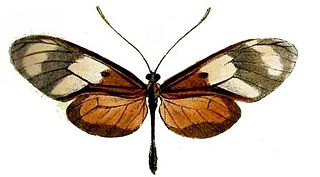- Papilio numataCramer, [1780]
- Eueides pione Hübner, 1816
- Heliconius numata var. melanops Weymer, 1894
- Heliconius numata var. guiensis Riffarth, 1900
- Heliconius numata isabellinus f. intermedia Boullet & Le Cerf, 1909
- Heliconius numata f. melanopors Joicey & Kaye, 1917
- Papilio silvana Stoll, [1781]
- Heliconius diffusus Butler, 1873
- Heliconius silvana var. divisus Kaye, 1906
- Heliconius numata silvaniformis Joicey & Kaye, 1917
- Heliconius silvana atakama Neustetter, 1931
- Heliconius dryalus Hopffer, 1869
- Heliconius ethra ab. brasiliensis Neustetter, 1907
- Heliconius ethra var. hopfferi Neustetter, 1907
- Heliconia aristiona Hewitson, [1853]
- Heliconius aristiona var. peruana Hopffer, 1879
- Heliconius aristiona var. splendidus Weymer, 1894
- Heliconius aurora Bates, 1862
- Heliconius numata var. isabellinus Bates, 1862
- Heliconius eupharius Weymer, 1890
- Heliconius gordius Weymer, 1894
- Heliconius floridus Weymer, 1894
- Heliconius seraphion Weymer, 1894
- Heliconius gradatus Weymer, 1894
- Heliconius aristiona aurora f. michaeli Neustetter, 1931
- Heliconius aristiona aurora f. deflavata Neustetter, 1932
- Heliconius aristiona idalion f. excelsa Neustetter, 1932
- Heliconius euphone C. & R. Felder, 1862
- Heliconius idalion Weymer, 1894
- Heliconius tleson Riffarth, 1901
- Heliconius aganippe Riffarth, 1901
- Heliconius aristiona lepidus Riffarth, 1907
- Heliconius idalion f. confluens Neustetter, 1912
- Heliconius euphone ab. nephele Seitz, 1916
- Heliconius euphone ab. confluxus Seitz, 1916
- Heliconius aristiona euphorbiusStichel, 1923
- Heliconius mixta Apolinar, 1927
- Heliconius numatus laura Neustetter, 1932
- Heliconius messene C. & R. Felder, 1862
- Heliconius sikinos Riffarth, 1901
- Heliconius aristiona messene f. juncta Neustetter, 1925
- Heliconius aristiona colombiana Apolinar, 1927
- Heliconius aristiona messene f. euphrasinus Neustetter, 1928
- Heliconius bicoloratus Butler, 1873
- Heliconius numatus sincerus Riffarh, 1907
- Heliconia numilia Herrich-Schäffer, 1865
- Heliconius aulicus Weymer, 1883
- Heliconius lenaeus Weymer, 1891
- Heliconius colepta Riffarth, 1901
- Heliconius lyrcaeus Weymer, 1891
- Heliconius timaeus Weymer, 1894
- Heliconius geminatus Weymer, 1894
- Heliconius mirus var. illustris Weymer, 1894
- Heliconius silvana mirificus Stichel, 1906
- Heliconius novatus subnutilus Stichel, 1906
- Heliconius superioris var. mavors Weymer, 1894
- Heliconius numata superioris ab. translata Joicey & Kaye, 1917
- Heliconius mirus Weymer, 1894
- Heliconius leopardus Weymer, 1894
- Heliconius spadicarius Weeks, 1901
- Heliconius arethusaRiffarth, 1901
- Helicons novatus obscurior Stichel, 1906
- Heliconius novatus artemis Riffarth, 1907
- Heliconius insolitus Avinoff, 1926
- Heliconius novatus f. confluens Neustetter, 1931
- Heliconius aristiona tarapotensis Riffarth, 1901
- Heliconius staudingeri Weymer, 1894
- Heliconius staudingeri var. pretiosus Weymer, 1894
- Heliconius aristiona lepidus f. gracilis Riffarth, 1907
- Heliconius aristiona timaeus f. aristeus Neustetter, 1931
- Heliconius aristiona staudingeri f. lutea Neustetter, 1931
|












